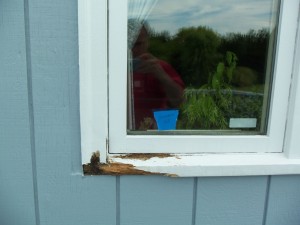Before the economic downturn, replacing windows was a fairly routine decision. The new economic reality we live in has forced homeowners to take a much harder look at that decision and look to do preventative maintenance in order to preserve the life of their windows. As house painting contractors in the Chicago area, we have welcomed that change in outlook on the part of consumers.
The most vulnerable parts of a window are, in this order: sill, bottoms of casing stiles, the bottom rail of the sash. When not maintained properly, these parts can quickly deteriorate and rot away. Most of time, the culprit is the moisture that intrudes through openings in the caulk and gets trapped in the lower components of the window listed above.
What do you do when rot has developed on window components? Replacing windows is an expensive proposition. With the carpentry and finishing costs involved, the replacement cost of a window can easily top $1000 and sometimes far exceed that amount, depending on the size and complexity of the window. Epoxy restoration and selective wood replacement can save homeowners a lot of money and greatly extend the life of the windows. Making the proper assessments to determine what can be restored with epoxy and where wood replacement is needed are key to the success of window restoration. In some cases, there is too much damage and the window or sash must be replaced, However, in most cases, restoration is the best choice!
The pictures, I have attached show a sash and sill in the process of being epoxy restored, a sill that has been restored and a sill that will require replacement because of the extensive damage.
When doing epoxy repairs, it is essential to remove all rotted fibers and make sure that the area has dried out completely before the epoxy is used. An epoxy consolidator must then be used to harden the soft fibers before the epoxy filler is used.
Finally, the cost of window maintenance can be reduced even further by doing a close by-yearly inspection of your windows and looking for any sign of failure in the caulking. That step will greatly reduce the chance of rot developing on the window components. This is how Painting in Partnership preserves your wallet, as well your windows!










 Follow
Follow








